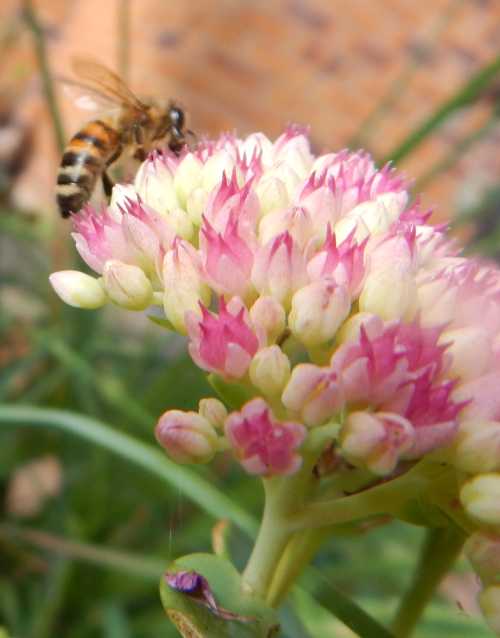Feed The Bees With Ice Plant (Sedum spectabile, or Hylotelephium spectabile)
If you are
looking for a late summer to autumn flowering hardy perennial for your garden,
and you want to attract bees and butterflies (not to mention hover flies), do
consider the late flowering succulent: ice plant - Hylotelephium spectabile - also known as Sedum spectabile.
Grow for ice plant for bees
This is a deciduous perennial, and it looks
fabulous in a rockery area or border (but note, this is an upright plant with some height, rather than a low-growing creeper).
I can certainly confirm that it is fantastic for attracting pollinators,
and is easy to divide and distribute to different parts of the garden, or to
give to friends and family.
I have a large patch in the front garden by the rockery. Until recently I had 2 patches in the back,
but I now have just the one. It spreads
nicely and adds interesting texture to the border as well as its pretty pinkish-red flowers into autumn.
 Ice plant - Hylotelephium spectabile is very attractive to bees, butterflies and other pollinators.
Ice plant - Hylotelephium spectabile is very attractive to bees, butterflies and other pollinators.This plant (being a succulent) has waxy leaves arranged in a kind of rosette fashion. The flowers develop from a pale greenish bud
that gradually opens up and becomes a pale to dark pink flower, depending on
the variety (whitish-cream flowered varieties are available).
Mine start to open from mid
to late August onwards, and flower well into September and even October, so they are
great for feeding hungry bees when other flowers are beginning to fade.
In fact, I find bees start to visit very soon after the small, individual flowers are open, whilst other buds remain closed. They seem very keen to get at the nectar.
 Honey bee - Apis melliferafeeding on ice plant - Hylotelephium spectabile - also known as Sedum spectabile.
Honey bee - Apis melliferafeeding on ice plant - Hylotelephium spectabile - also known as Sedum spectabile.Ice plant (Sedum spectabile) attract a variety of bumble bees and honey
bees.
 Common carder bumble bee - Bombus pascuorum foraging on ice plant - Hylotelephium spectabile.
Common carder bumble bee - Bombus pascuorum foraging on ice plant - Hylotelephium spectabile.Ice plant likes full sun and well-drained soil, although the patch
in my rear garden has light shade for a large part of the day and it’s doing
fine. It’s also a handy plant to have if
you have a garden that needs to cope with drought conditions.
As well as dividing the plants in spring, you can also take softwood cuttings.
As the plant dies back naturally for the winter months, the flower heads take on a dried appearance. I rather like these, so I leave them until the following year once the threat of frost has past. My theory is that this will help to protect the emerging new growth during cold snaps.
When pulling away the old flower stalks, I'm careful to ensure I don't take new growth with them, as it can pull away easily.
In general, I tend to leave the seed heads on most plants, primarily for the birds, though I have never seen birds feeding from ice plant - I'm not sure whether they do or not.
Which ice plant varieties to grow for bees?
You could try:
Hylotelephium spectabile ‘Carl’
Hylotelephium spectabile 'Brilliant'
Hylotelephium spectabile 'Stardust'
A related plant called Hylotelephium 'Herbstfreude' also has excellent reports regarding its attractiveness for pollinators.
 Not all of the little flowers are open, nevertheless, ice plant is irresistible to bees.
Not all of the little flowers are open, nevertheless, ice plant is irresistible to bees.
Pests and diseases
My plants have in the past suffered with a type of root rot or
fungus – not sure exactly what the disease was, but I believe the disease was present in the soil.
I had this problem for a couple of years running, including with a few other plants in the same area of the garden.
I pulled out any rotting stems. As it happens, I treated the ground area with a seaweed feed (mine was called ‘Maxicrop’), as I had heard (unofficially) that it seems to help prevent pest attack on plants, shrubs and trees. I wanted to try it as a natural ingredient to help protect my plum tree, so I treated the soil around it - this being the same location of one of my patches of Sedum.
Anyway, not only have I found the seaweed feed to be effective against fruit tree pests (I treat the ground yearly, early in spring) I have also found I no longer have problems with the disease that troubled my ice plant - or other plants close by.
I later read that indeed, seaweed is effective as a preventative against fungal and other plant diseases.
